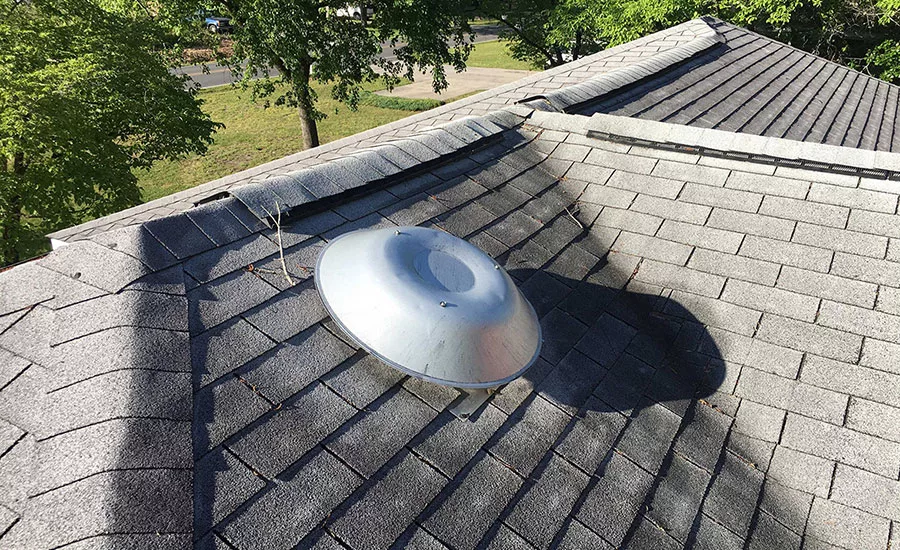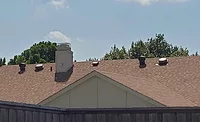For PEAK Results Go with Ridge Vents

Unlike ridge vents, wind turbines and box vents only provide localized exit points with “dead spaces” in between the vents.
The roofing contractor is preparing an estimate for a brand new roof for the homeowner and it’s time to evaluate the existing attic ventilation. The roof’s generous horizontal ridge line makes it the perfect candidate for ridge vents along the peak of the roof. But already in place are multiple wind turbines or a bunch of individual box vents (also called roof louvers, static vents or can vents). It’s decision time for the roofing contractor:
- Keep quiet and simply estimate the cost to replace the same exact attic exhaust vents already in place – either the wind turbines or the box vents?
- Or, recommend to the homeowner a better looking and better performing option with ridge vents?
Let’s help the contractor with the decision: The material and labor required to install ridge vents is less than what it costs to install either wind turbines or box vents in the quantity that matches the airflow performance of the ridge vents.
And if you’re wondering about the cost that will be incurred to cover the existing holes in the roof from the existing wind turbines or box vents when switching to ridge vents, it’s minimal. It’s $30 per hole, taking on average nine minutes per hole to cover, according to our recent survey of roofing contractors. That cost can be rolled into the overall estimate and explained to the homeowner when given the chance to understand the improvement they will enjoy with ridge vents.
Ridge vents perform better. Ridge vents look better. And ridge vents cost less in material and labor.
Money Matters
During the best practices in residential attic ventilation seminars that I host across North America for roofing pros, significant time is spent comparing the performance of ridge vents and the aesthetics of ridge vents to other non-motorized attic exhaust vents such as wind turbines and box vents. The science and research both point directly to ridge vents for superior performance because they allow a continuous, non-stop exit airflow by being installed all along the peak of the roof. Wind turbines and box vents only provide localized exit points with “dead spaces” in between the vents.
Likewise, homeowner feedback via our customer service hotline strongly indicates a preference for the low-profile look of ridge vents with matching shingles installed on top. They really are nearly invisible on the roof.
But for this article, seminar attendees asked that we focus where the choice of attic ventilation directly impacts the roofing contractor – his or her wallet.
We’ll set performance and cosmetics aside even though they are (or should be) important to both the roofing contractor and the homeowner. Let’s cut to the chase: Which is going to cost the contractor the least amount of money to install? The answer is ridge vents.
For example, say a 1,500-square-foot attic (length by width, floor of the attic) has 42 linear feet of horizontal roof peak available on which functioning ridge vent can be installed. Most ridge vents on the market provide 18 square inches of airflow per linear foot (usually expressed as Net Free Area, or NFA).
- Multiply 42 linear feet of ridge vent by 18 square inches NFA per linear foot = 756 total square inches of Net Free Area installed (exhaust ventilation)
- To match the ridge vent’s exhaust airflow output using wind turbines, it would take: Five 14-inch wind turbines (each at 132 square inches NFA) or eight 12-inch wind turbines (each at 95 square inches NFA)
- To match the ridge vent’s exhaust airflow output using box vents, it would take: 15 box vents (each at 50 square inches NFA)
In a survey of roofing contractors across North America, we asked their costs to purchase and then install each of the vents in the three scenarios above.
- $388 for 42 linear feet of externally baffled, 4-foot stick ridge vent
- $424 for 15 plastic box vents
- $483 for 15 metal box vents
- $527 for five 14-inch wind turbines
And for the roofing contractors reading this thinking, “That’s ridiculous. I’m not going to install 15 box vents. That’s too many. That’s not real world.” But that’s exactly how many it takes to match the performance of the ridge vent. Any fewer and the homeowner’s attic exhaust has been shortchanged.
What About the Existing Holes?
The cost comparison above does not include the money to cover the existing holes in the roof under each wind turbine or box vent that is about to be replaced with ridge vent. On average, our survey respondents said it costs $30 per hole and takes about nine minutes per hole, either by using a quick plug fix or actually replacing a full sheet of decking. Thinking this might be a deterrent to making the switch to ridge vents – the cost and time to deal with the holes – we asked roofing contractors what they thought. Overwhelmingly (86%), they said it is not a deterrent. A few noteworthy comments from the survey:
- “It is never a deterrent to using ridge vent,” said Patrick Readyhough, president, Pond Roofing Company Inc., Fairfax, Va.
- “Yes, it’s a deterrent, but it’s slight,” said Jake Jacobson, vice president of sales, SF5 Construction, Little Elm, Texas. “What greatly tips the balance is the satisfaction of the customer when we explain why we remove the wind turbines or box vents and install the ridge vent in their place.”
- “If covering the holes is a deterrent to switching to ridge vent, that’s a lazy roofer,” said Shawn Bellis, owner, Epic Exteriors, Overland Park, Kan.
Durability, Damage Costs
If a roofing contractor is still on the fence about making the switch to ridge vents on the next suitable replacement roof project, here’s one more factor to consider: vent durability.
“One expense that is often overlooked is to assume that box vents, wind turbines and ridge vents are equal in durability,” said Jacobson. “It is virtually impossible to damage or destroy ridge vent, but wind turbines and box vents are made of metal and can get damaged in transit as well as during installation. That’s the real added cost. You order five wind turbines and one of them gets damaged in transit or during installation. Now you have to hot shot a special order to replace that damaged product.”
Looking for a reprint of this article?
From high-res PDFs to custom plaques, order your copy today!






